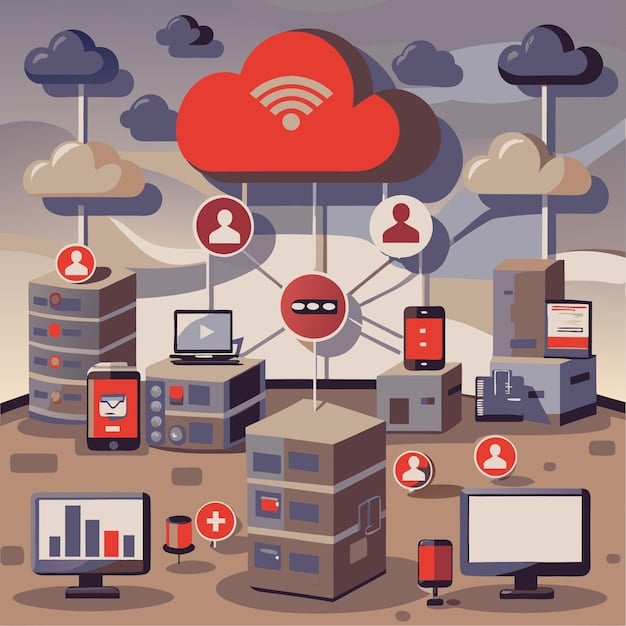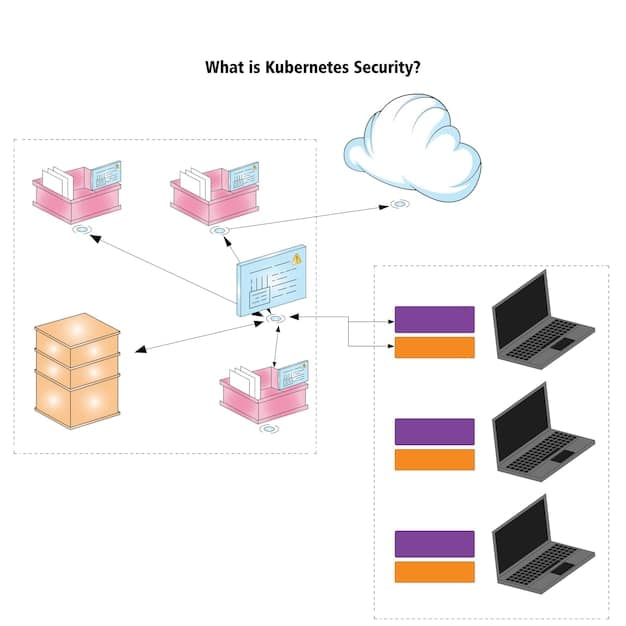Cloud Networking Security Breaches: Recent US Examples & Prevention

Cloud networking security breaches are a significant concern for organizations in the US. Recent examples underscore the need for robust security measures, including advanced threat detection, data encryption, and comprehensive identity management to safeguard sensitive data and infrastructure.
The rise in cloud adoption has brought unparalleled flexibility and scalability, but it has also opened new doors for cybercriminals. In this article, we’ll explore recent **cloud networking security breaches** in the US, examine the vulnerabilities exploited, and provide actionable strategies to prevent future incidents.
Understanding Cloud Networking Security Risks
Cloud networking offers numerous benefits, but it also introduces unique security challenges. Understanding these risks is crucial for building a robust defense against potential breaches. Without proper precautions, businesses become attractive targets for malicious actors.
What are the most common vulnerabilities in cloud networking environments?
Common Cloud Security Vulnerabilities
- Misconfigurations: Incorrectly configured cloud services are a leading cause of breaches.
- Weak Access Controls: Poorly managed user access and authentication mechanisms can be easily exploited.
- Data Breaches: Unauthorized access to sensitive data stored in the cloud can have severe consequences.
- Inadequate Encryption: Insufficient encryption leaves data vulnerable to interception and theft.
The interconnected nature of cloud networks increases the attack surface, making it essential to implement robust security measures.

Recent Cloud Networking Security Breaches in the US
Examining recent security breaches provides valuable insights into the tactics used by cybercriminals and the potential impact of successful attacks. By analyzing these incidents, organizations can learn from past mistakes and strengthen their defenses.
Let’s delve into three prominent examples of cloud networking security breaches that have affected US organizations.
Example 1: Data Breach at a Healthcare Provider
A major healthcare provider experienced a data breach due to a misconfigured cloud storage service. Sensitive patient data, including medical records and personal information, was exposed to unauthorized access. This incident highlighted the importance of regularly reviewing and securing cloud configurations.
Example 2: Ransomware Attack on a Financial Institution
A financial institution fell victim to a ransomware attack that targeted its cloud-based infrastructure. The attackers gained access through a phishing campaign and encrypted critical data, demanding a ransom payment. This illustrates the need for strong email security and employee training.
What preventive steps could have mitigated these attacks?
Example 3: Supply Chain Attack Targeting a Software Vendor
A software vendor experienced a supply chain attack that compromised its cloud environment. Attackers gained access through a third-party application with weak security controls, allowing them to inject malicious code into the vendor’s software. This underscores the need to vet third-party vendors and implement robust supply chain security measures.
These examples demonstrate the range of threats facing organizations that rely on cloud networking. It is essential to implement a layered security approach to protect against these risks.
Key Strategies for Preventing Cloud Networking Security Breaches
Preventing cloud networking security breaches requires a proactive and comprehensive approach. Implementing the right security measures can significantly reduce the risk of a successful attack. Organizations must adopt a defense-in-depth strategy to protect against a variety of threats.
What are the most effective strategies for securing cloud networks?
Implement Strong Identity and Access Management (IAM)
IAM is critical for controlling access to cloud resources and preventing unauthorized access. Organizations should implement multi-factor authentication (MFA), role-based access control (RBAC), and regular access reviews to ensure that only authorized users have access to sensitive data.
Encrypt Data at Rest and in Transit
Encryption is essential for protecting data from unauthorized access, both when it is stored in the cloud and when it is being transmitted. Use strong encryption algorithms and manage encryption keys securely to prevent data breaches.

Enhancing Threat Detection and Incident Response Capabilities
Early detection of security threats is crucial for minimizing the impact of a potential breach. Organizations should implement robust threat detection and incident response capabilities to identify and respond to security incidents quickly and effectively. A well-defined incident response plan is essential for mitigating the damages caused by a breach.
How can organizations improve their threat detection and incident response capabilities?
Utilize Security Information and Event Management (SIEM) Systems
SIEM systems provide real-time monitoring and analysis of security events, allowing organizations to detect and respond to threats quickly. SIEM systems can collect logs from various sources, correlate events, and generate alerts when suspicious activity is detected.
Implement Intrusion Detection and Prevention Systems (IDPS)
IDPS can detect and prevent malicious activity by monitoring network traffic and system logs. IDPS can identify known attack patterns and block or quarantine suspicious traffic. Regular updates and tuning are necessary to ensure that IDPS remains effective against emerging threats.
- Regularly update and patch systems and applications
- Conduct regular security audits and vulnerability assessments
- Implement a comprehensive incident response plan
A proactive approach to threat detection and incident response is critical for minimizing the impact of a security breach.
The Importance of Continuous Monitoring and Compliance
Continuous monitoring and compliance are essential for maintaining a secure cloud networking environment. Organizations should implement monitoring tools to track system performance, security events, and compliance with industry regulations. Staying compliant with relevant regulations also helps reduce the risk of legal and financial penalties.
Why are continuous monitoring and compliance so important?
Regularly Monitor Cloud Security Posture
Continuous monitoring of cloud security posture allows organizations to identify and address vulnerabilities quickly. Monitoring tools can track changes to cloud configurations, detect unauthorized access, and identify potential security risks. Automated monitoring can help organizations stay ahead of potential threats.
Ensure Compliance with Industry Regulations
Compliance with industry regulations, such as HIPAA, PCI DSS, and GDPR, is essential for protecting sensitive data and avoiding legal and financial penalties. Organizations should implement controls to ensure that they are meeting regulatory requirements and conduct regular audits to verify compliance.
A strong compliance program demonstrates a commitment to security and helps build trust with customers and partners.
Training and Awareness Programs for Employees
Employees are often the first line of defense against cyberattacks. Providing regular training and awareness programs can help employees recognize and avoid security threats. Educated employees are more likely to identify phishing attempts, report suspicious activity, and follow security best practices.
What topics should be included in employee training programs?
Phishing Awareness Training
Teach employees how to identify and avoid phishing emails, which are a common method used by attackers to gain access to cloud environments. Regularly test employees with simulated phishing attacks to reinforce their training.
Password Security Best Practices
Educate employees on the importance of using strong, unique passwords and avoiding password reuse. Encourage the use of password managers to help employees generate and store strong passwords securely.
Investing in employee training and awareness programs is a cost-effective way to improve cloud networking security.
Leveraging Automation for Enhanced Security
Automation can play a significant role in improving cloud networking security by reducing manual effort and minimizing the risk of human error. Automated security tools can help organizations streamline security processes, improve efficiency, and enhance threat detection and response capabilities. Automation tools also ensure consistent application of security policies.
How can automation be used to enhance cloud security?
Automated Configuration Management
Use automated configuration management tools to ensure that cloud resources are configured securely and consistently. These tools can automatically detect and remediate misconfigurations, reducing the risk of security breaches.
Automated Vulnerability Scanning
Implement automated vulnerability scanning tools to identify and address security vulnerabilities in cloud environments. These tools can automatically scan systems and applications for known vulnerabilities and provide recommendations for remediation.
By leveraging automation, organizations can significantly improve their cloud networking security posture and reduce the risk of security breaches.
| Key Aspect | Brief Description |
|---|---|
| 🛡️ Strong IAM | Implement MFA & RBAC to control access to resources. |
| 🔒 Data Encryption | Encrypt data at rest and in transit for protection. |
| 🚨 Threat Detection | Use SIEM/IDPS for real-time monitoring and response. |
| 🧑🏫 Employee Training | Train employees on security best practices & phishing. |
Frequently Asked Questions (FAQ)
▼
Cloud networking security involves practices and technologies to protect data, applications, and infrastructure hosted in cloud environments from cyber threats.
▼
It ensures confidentiality, integrity, and availability of sensitive data, preventing data breaches, financial losses, and reputational damage.
▼
Common threats include misconfigurations, weak access controls, data breaches, ransomware attacks, and supply chain vulnerabilities affecting US businesses.
▼
Implement strong IAM, data encryption, threat detection, and employee training programs, while ensuring regular monitoring and compliance.
▼
Automation streamlines security processes, minimizes human error, and enhances threat detection and response capabilities through automated tools and configurations.
Conclusion
Securing cloud networking environments requires a multifaceted approach that combines robust security controls, continuous monitoring, and proactive threat management. By implementing the strategies discussed in this article, organizations can significantly reduce the risk of **cloud networking security breaches** and protect their critical assets.





